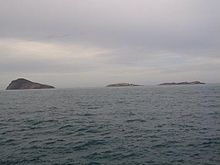Chafarinas Islands
| Disputed islands | |
|---|---|
 Chafarinas Islands viewed from Morocco | |
| Geography | |
 | |
| Location | Mediterranean sea |
| Total islands | 3 |
| Major islands | Isla del Congreso Isla Isabel II Isla del Rey |
| Area | 52.5ha |
| Administered by | |
| Spain | |
| Claimed by | |
| Morocco | |

The Chafarinas Islands (Spanish: Islas Chafarinas IPA: [ˈizlas tʃafaˈɾinas], Berber: Igumamen Iceffaren or Takfarinas, Arabic: جزر الشفارين or الجزر الجعفرية), also spelled Zafarin, Djaferin[1] or Zafarani,[2] are a group of three small islets located in the Alboran Sea off the coast of Morocco with an aggregate area of 0.525 square kilometres (0.203 sq mi), 45 km (28.0 mi) to the east of Nador and 3.3 km (2.1 mi) off the Moroccan town of Ras Kebdana.
The Chafarinas Islands are one of the Spanish territories in North Africa off the Moroccan coast known as plazas de soberanía.
History[]
These offshore islands were uninhabited and unclaimed in 1848, when the French government decided to occupy them, in order to monitor the tribes living in the border area between Morocco and French Algeria. A small expedition under the command of Colonel MacMahon (the future Marshal MacMahon) left Oran by sea and by land in January 1848 to take possession of the islands. Forewarned by its consul in Oran, Spain, which also coveted the Chafarinas, quickly dispatched a warship to the islands from Malaga. When the French arrived, the Spaniards had already taken possession of the islands in the name of Queen Isabel II.[3]
Geography[]
The Chafarinas Islands are made up of three islands (from west to east, with areas in hectares):
- Isla del Congreso (25.6 ha)
- Isla Isabel II (15.3 ha) (with garrison)
- Isla del Rey (11.6 ha).
Under Spanish control since 1847, there is a 30-man[4] military garrison on Isla Isabel II, the only stable population on the small archipelago, down from 426 people in 1900 and 736 people in 1910. Small numbers of scientists, anti-trafficking police, and other authorized personnel sometimes increase the population to around 50.
Natural history[]
The islands had a certain relevance in Spanish environmentalist circles during the 1980s and 1990s as the last individual of Mediterranean monk seal in Spanish territory lived there until it disappeared in the 1990s.[5] Nine out of eleven of its marine invertebrates are considered endangered species and it is the home of the second largest colony of endangered Audouin's gull in the world.[6] The islands have been recognised as an Important Bird Area (IBA) by BirdLife International because they support, as well as the Audouin's gull colony, a breeding colony of Scopoli's shearwaters, with some 800–1,000 breeding pairs estimated in 2001–2004.[7]
Gallery[]

Islas Chafarinas as seen from

Audouin's gull, one of the numerous inhabitants on the islands

Island of Isabel II

Church of la Purísima Concepción on the island of Isabel II in 1893

Coat of arms of the Chafarinas Islands
See also[]
| Wikisource has the text of the 1911 Encyclopædia Britannica article Chaffarinas. |
- Plazas de soberanía
- List of Spanish Colonial Wars in Morocco
- Spanish Protectorate of Morocco
References[]
| Wikimedia Commons has media related to Chafarinas Islands. |
- ^ "Chafarinas Islands". Encyclopædia Britannica. 2011. Retrieved September 7, 2011.
- ^ "Index of Countries and Localities". USPS. 2011. Retrieved September 7, 2011.
- ^ L'Exploration, Paris, vol. 18, 2nd semester 1884, p. 531.
- ^ "Unos 30 militares integran guarnición militar que vigila las islas Chafarinas".
- ^ (http://WWW.CONSUMER.ES/), EROSKI CONSUMER. "Foca monje del Mediterráneo - EROSKI CONSUMER". Archived from the original on 2018-06-13. Retrieved 2007-12-14.
- ^ Ceberia, Monica et al (17 September 2012) The last remains of the empire El Pais in English, Retrieved 24 September 2012
- ^ "Chafarinas Islands". BirdLife Data Zone. BirdLife International. 2021. Retrieved 14 February 2021.
- Chafarinas Islands
- Islands of Africa
- Archipelagoes of Spain
- Mediterranean islands
- Plazas de soberanía
- Territorial disputes of Spain
- Archipelagoes of Africa
- Natura 2000 in Spain
- Important Bird Areas of Spain
- Important Bird Areas of Mediterranean islands
- Seabird colonies





